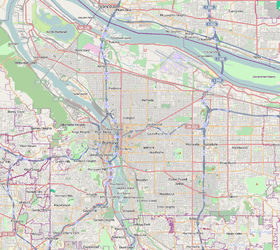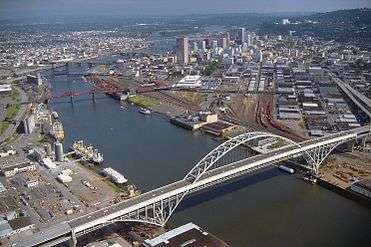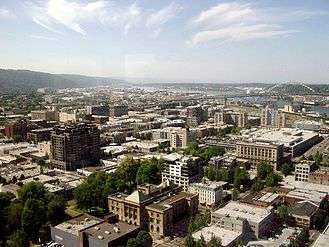Pearl District, Portland, Oregon
| Pearl District | |
|---|---|
| Neighborhood | |
 Pearl District | |
|
Coordinates: 45°31′48″N 122°40′53″W / 45.53012°N 122.68136°WCoordinates: 45°31′48″N 122°40′53″W / 45.53012°N 122.68136°W PDF map | |
| Country | United States |
| State | Oregon |
| City | Portland |
| Government | |
| • Association | Pearl District Neighborhood Association |
| • Coalition | Neighbors West/Northwest |
| Area | |
| • Total | 0.47 sq mi (1.21 km2) |
| Population (2010[1])[3] | |
| • Total | 5,997 |
| • Density | 13,000/sq mi (5,000/km2) |
| Housing[3] | |
| • No. of households | 5315 |
| • Occupancy rate | 79% occupied |
| • Owner-occupied | 1493 households (28%) |
| • Renting | 2699 households (51%) |
| • Avg. household size | 1.13 persons |
The Pearl District is an area of Portland, Oregon, formerly occupied by warehouses, light industry and railroad classification yards and now noted for its art galleries, upscale businesses and residences. The area has been undergoing significant urban renewal since the mid-1980s when it was reclassified as mixed use from industrial,[4] including the arrival of artists, the removal of a viaduct and construction of the Portland Streetcar. It now mostly consists of high-rise condominiums and warehouse-to-loft conversions.
The increase of high-rise condominiums and warehouse-to-loft conversions was made evident with the construction of the Cosmopolitan on the Park building, which opened in Summer 2016. The Cosmopolitan on the Park residential building is now the tallest building in the Pearl District and the 8th tallest building in Portland, contributing to the changing Portland skyline.[5]
The area is located just northwest of downtown between West Burnside Street on the south, the Willamette River on the north, NW Broadway on the east and the Interstate 405 freeway on the west.[6]
The area is home to several Portland icons, including Powell's City of Books. The former Weinhard Brewery, which operated continuously from 1864 to September 1999, was shut down by Stroh's upon the purchase of the Weinhard's brand by Miller Brewing and sold for redevelopment as the Brewery Blocks.[7] There are art galleries and institutions such as the Elizabeth Leach Gallery and Blue Sky Gallery (many who stage monthly receptions), boutiques, and restaurants abound, and also a number of small clubs and bars, a combination that has led to Pearl District being named one of the 15 coolest neighborhoods in the world in 2016.[8] The United States Post Office main processing facility for all of Oregon and southwestern Washington was built in the Pearl District in 1964, next to Union Station. This location was chosen in order for the post office to be able to better serve towns outside the Portland metro area.
The district includes most of the historic North Park Blocks (1869), as well as three public plazas:
- Jamison Square (2002) is built around a fountain which simulates a tidal pool that is periodically filled by artificial waterfalls and then drained into grating.
- Tanner Springs Park (2005) is a re-created natural area featuring wetlands, a walking trail, and creek.
- The Fields Park (2013) is a Neighborhood and Dog Park in the Northern part of the Pearl.[9] The Park provides space for visual or performing arts, for community-building activities and has a large paved walking loop.
History
The area was formerly used for warehousing, light industrial purposes and a railroad yard and was known as the "Northwest Industrial Triangle".[10]
In the 1990s, the Lovejoy Viaduct, an elevated portion of NW Lovejoy Street from the Broadway Bridge past NW 10th Avenue was demolished, opening dozens of surrounding blocks (including some brownfield sites) for development, which peaked in the 2000s. The viaduct was notable for the Lovejoy Columns, painted by a railroad watchman who worked below; two of them have been saved.[11] The increasing density has attracted a mix of restaurants, brewpubs, shops, and art galleries.
The origins of how the Pearl District got its name is still up for debate. According to the Pearl District Business Association, Thomas Augustine, a local gallery owner, coined the name Pearl District around the turn of the millennium to suggest that some of its urban decay industrial buildings were like crusty oysters, and that the galleries and artists' lofts within were like pearls. However, in 2002, Thomas Augustine amended his story, suggesting that the idea for the Pearl District came from his friend Pearl Marie Amhara who would throw parties for creatives in warehouses in what is now considered the Pearl District. Attendees started calling the area “Pearl’s place” and “Pearl’s District”. Local business people were looking to label the growing area and the name finally caught on when a writer for Alaska Airlines borrowed and popularized Augustine's phrase. The "warehouse district" or the "brewery district" were two other suggestions that are still used today.[12][13]
The movie Drugstore Cowboy (1989), by Gus Van Sant, has several scenes shot in the neighborhood.
|
References
- ↑ "PortlandMaps". www.portlandmaps.com. Archived from the original on 21 February 2008. Retrieved 24 April 2018.
- ↑ "PortlandMaps". www.portlandmaps.com. Archived from the original on 21 February 2008. Retrieved 24 April 2018.
- 1 2 Demographics (2010[2])
- ↑ "Marshall-Wells Lofts <> History". www.marshall-wells.com. Archived from the original on 25 February 2017. Retrieved 24 April 2018.
- ↑ Nextportland (2014-12-09). "North Pearl High-Rises, Part I: The Cosmopolitan on the Park (images)". Next Portland. Archived from the original on 2017-02-02. Retrieved 2017-01-31.
- ↑ City of Portland, Oregon Office of Neighborhood Involvement/Bureau of Planning (June 1, 2001). "Pearl Neighborhood Association boundary map" (PDF). Archived from the original on December 2, 2008.
- ↑ "Mixed Use Brewery Blocks" Archived 2008-06-10 at the Wayback Machine.. Accessed online 16 July 2008.
- ↑ "The 15 Coolest Neighborhoods in the World in 2016". Archived from the original on 3 December 2016. Retrieved 13 November 2016.
- ↑ "The Fields Park". City of Portland. Archived from the original on 29 June 2011. Retrieved 12 July 2011.
- ↑ Don Hamilton (April 29, 2005). "More polish for the Pearl". Portland Tribune. Archived from the original on February 21, 2008. Retrieved January 31, 2015.
- ↑ "More on the Lovejoy Columns". Portland Architecture. Archived from the original on 4 June 2015. Retrieved 24 April 2018.
- ↑ Margie Boule (April 14, 2002). "Pearl District's namesake was a jewel of a woman". The Oregonian. Archived from the original on April 10, 2015.
- ↑ "How Did the Pearl District Get Its Name?". Pearl District Neighborhood Association. 2014-01-06. Archived from the original on 2015-09-12. Retrieved 2017-01-31.
External links
| Wikimedia Commons has media related to Pearl District (Portland). |

